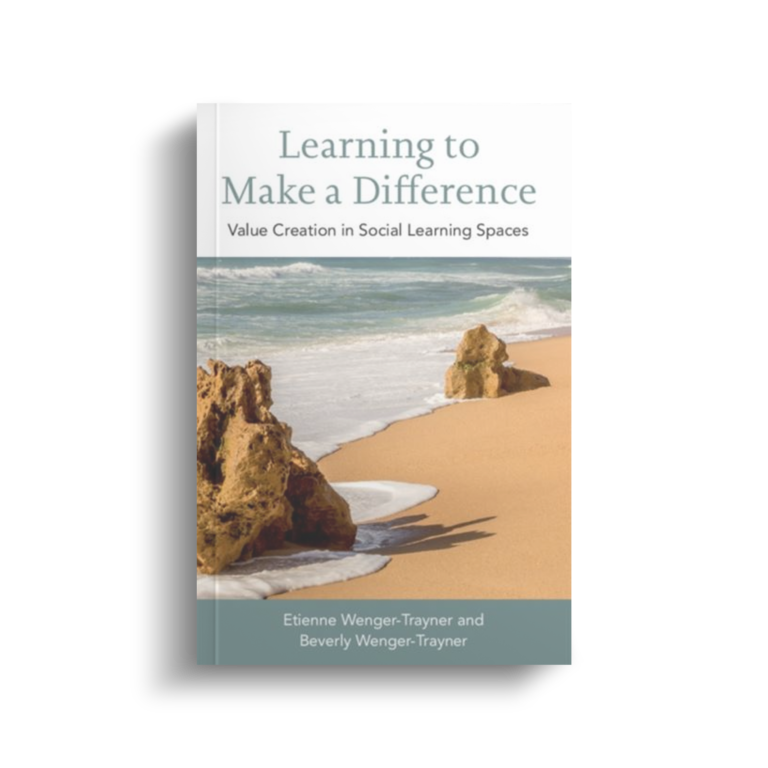Social learning spaces
the art of learning together
Keywords
Caring to make a difference
Engaging uncertainty
Paying attention
Agency
Learning loops
Value creation
Power
What they are
A social learning space is an event of mutual engagement in learning. It arises when a group of people, each eager to figure out how to do something important to them, discover and experience each other as learning partners.
A social learning space can arise spontaneously or intentionally; one can happen in all sorts of places and circumstances—in a chance meeting on a train, in a side conversation at a conference, or during a workshop or community meeting that was carefully designed as such.
A more formal definition
The social learning capability inherent in a social learning space derives from its very definition. Technically, we define a social learning space as an event arising out of the combination of three factors of participation:
- Caring to make a difference. Participants engage in the space because they see a chance to enhance their ability to affect the world or themselves in a way they care to. Participants in the space do not necessarily care to make the same difference, but they see enough value in a learning encounter to participate, whether it is their primary motive for being there and whether their aspiration is lofty or pedestrian, clearly formulated or incrementally recognized.
The social experience of this urge to make a difference is the key driver of social learning capability.
- Engaging uncertainty.When participants care to make a difference, what a social learning space offers is a chance to address their uncertainties about making that difference: what it means, whether it is worth making or possible at all, and above all, possible ways for how to go about it. Engaging uncertainty is that state of tension between caring to make a difference and seeing the next steps. It can be experienced cerebrally or viscerally, in the emotions and the body. It can be expressed verbally or in different ways through body language, a questioning stance, intonation.
This engagement of uncertainty gives birth to social learning capability because it opens a space for social learning.
- Paying attention. When you engage your uncertainty about something you care about, the world starts talking to you. Even the absence of a response is a kind of response. Sometimes it manifests as an attentive listening attitude or, at the other extreme, it manifests as a driving quest to seek feedback proactively or to gather and analyze data systematically. Paying attention is not the same as taking feedback at face value. It is an active dance between accepting, taking in, thinking about, resisting, and refusing feedback. Often it requires unlearning. It might result in a new understanding, a corrected fact, a refined insight, slight adjustments in a process, a new perception, a lighter heart, a shift in approach, a revision of assumptions, a steelier resolve, or the decision to collect further data.
This willingness to pay attention is essential to social learning capability because it enables what is happening in a social learning space to affect how participants go about their lives.
How they contribute to social learning capability
It is because of the confluence of these three dimensions that a social learning space acts as a contained unit of social learning capability. In this sense, the notion of social learning space is a bit like the cell in living organisms—the simplest unit that contains all the components of life. It can both live on its own and be part of more complex organisms. Just as an organism depends on the health of sometimes trillions of cells, social learning capability is not a unitary characteristic, but one made up of disparate social learning spaces. Just as cells reproduce to repair a damaged organism, social learning spaces can recover social learning capability in a broader system that has become paralyzed.
On the other hand, we ask ourselves if an overly rapid proliferation of social learning spaces on a runaway topic—as in unchecked cell growth—might develop into the equivalent of a tumor. We have yet to find out. Social learning spaces can spring up anywhere, but they can quickly dissolve. They are fragile and easily choked by power plays. A conversation around the dinner table could turn into a social learning space, but it can also quickly turn into an opportunity to bring up old grievances. An expression of doubt at an event could be the seed of a social learning space or an opportunity seized by someone to show off what they know.
Our experience with groups suggests that all three dimensions present challenges: getting a grasp on the difference you care to make, uncovering your uncertainties in ways that make them discussable, and committing to paying attention to see new things. Each of the three dimensions can be realized to a greater or lesser extent, and their distribution among participants can vary. Something can be more or less of a social learning space, and more or less so for different participants. Even though social learning spaces are everywhere, they can remain local or fleeting events. Nonetheless, once the three dimensions truly converge, they can form social space with an irresistible call for participation. This has the potential to enhance the learning capability of the broader landscape.
More on social learning spaces
Workshops and events
The learning model of a social learning space is addressed in all our workshops, but especially our cutting-edge BEtreats.

